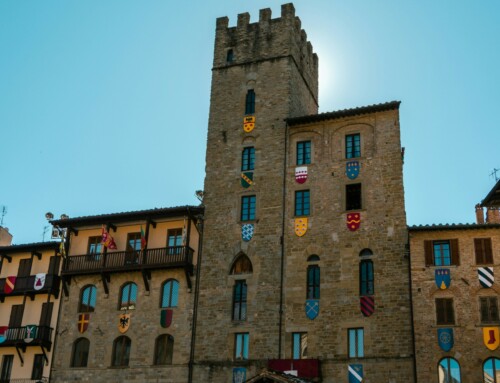The Basilica of St. Dominic in Arezzo: A Historical and Artistic Treasure

The Basilica of San Domenico in Arezzo, built from 1240 by the Dominican friars and financially supported by the Ubertini and Tarlati families, is known for its asymmetrical facade and for being a symbol of the encounter between art and faith. Witnessing the artistic evolution between the 14th and 15th centuries, it hosted the first Conclave in 1276. Despite historical challenges, such as its abandonment in 1782, today the basilica, located near the Cathedral of Saints Peter and Donatus, enchants with Gothic stained glass windows, frescoes and works by artists such as Cimabue and Spinello Aretino. Recognized by UNESCO, it is an essential stop on a cultural exploration of Arezzo, easily accessible from the Poggio Del Drago B&B.
The Basilica of St. Dominic , dedicated to the founder of the Dominican order, is a monument of exceptional beauty and significance for the city.
Origin and Architecture of the Basilica of St. Dominic
Dominating the square to which it gives Arezzo its name, the Basilica of San Domenico is distinguished by its unique asymmetrical facade. Begun by Dominican friars around 1240, its construction, which included a convent, extended until the early 1300s. It was strongly supported by the influential Arezzo Ubertini and Tarlati families, who contributed greatly to its construction. Architecturally, the basilica shows affinities with the Basilica of Santa Maria Novella in Florence.
Cultural and Artistic Relevance
During the 14th and early 15th centuries, the interior of the basilica became the center of local painting, influenced by the Sienese and Florentine schools, while maintaining a distinctive style. The Basilica of San Domenico bears witness to the meeting of styles and influences that have characterized Arezzo over the centuries, becoming a place where art and faith intertwine, symbolizing the city’s cultural heritage. In 1276, it also hosted the first Conclave in the history of the Catholic Church.
Challenges in the Course of History
The Basilica, despite its historical importance, has not been exempt from changes over time. In 1782, it was abandoned following a reform of religious orders in the Grand Duchy of Tuscany and remained unused until the 20th century.
Location of the Basilica
Located in Piazza San Domenico, near the Cathedral of Saints Peter and Donato, the Church is easily accessible from the B&B Cento Passi Dal Duomo, being within walking distance.
Enchanting Interiors of the Basilica of St. Dominic
Inside, the Basilica enchants with its magnificence. Twelve Gothic stained glass windows illuminate the main corridor, adorned with frescoes and paintings from the 14th century. Two Renaissance works by Arezzo artists, including Spinello Aretino’s “Saints Philip and James Minor and Stories of Their Lives and St. Catherine” and Parri di Spinello’s “The Crucifixion between the Virgin, St. Nicholas, St. John and St. Dominic,” adorn the counterfaçade.
Headpieces and Monument to Blessed Angelico
The church preserves significant works, such as Cimabue’s Crucifix of St. Dominic, a prelude to the Renaissance. It also houses Beato Angelico’s funerary monument by Andrea della Robbia, as well as notable sculptures such as the Gothic altar by Giovanni di Francesco da Firenze and glazed terracottas by della Robbia.
Unesco World Heritage Site
In 1998, the Basilica of San Domenico was recognized as a UNESCO World Heritage Site, part of Arezzo’s historic-artistic complex along with Piazza Grande and the Cathedral of San Donato.
The Basilica of St. Dominic: An Essential Stop
Visiting the Basilica of San Domenico is essential for anyone in Arezzo, offering an extraordinary specimen of Tuscan Gothic art and architecture. Its historicity and artistic value make it a world-renowned tourist destination.
Discover Arezzo with Poggio Del Drago
The Basilica of San Domenico is just the beginning of the historical and artistic discoveries to be made around the B&B Country House Poggio Del Drago. On our website, you can find additional must-see sights such as the Cathedral of Saints Peter and Donato, the Ivan Bruschi House Museum and the Birthplace of Francesco Petrarca. The B&B Poggio Del Drago awaits you for an unforgettable cultural experience.
Photograph kindly provided by Arezzo photographer Raul Dominici.




